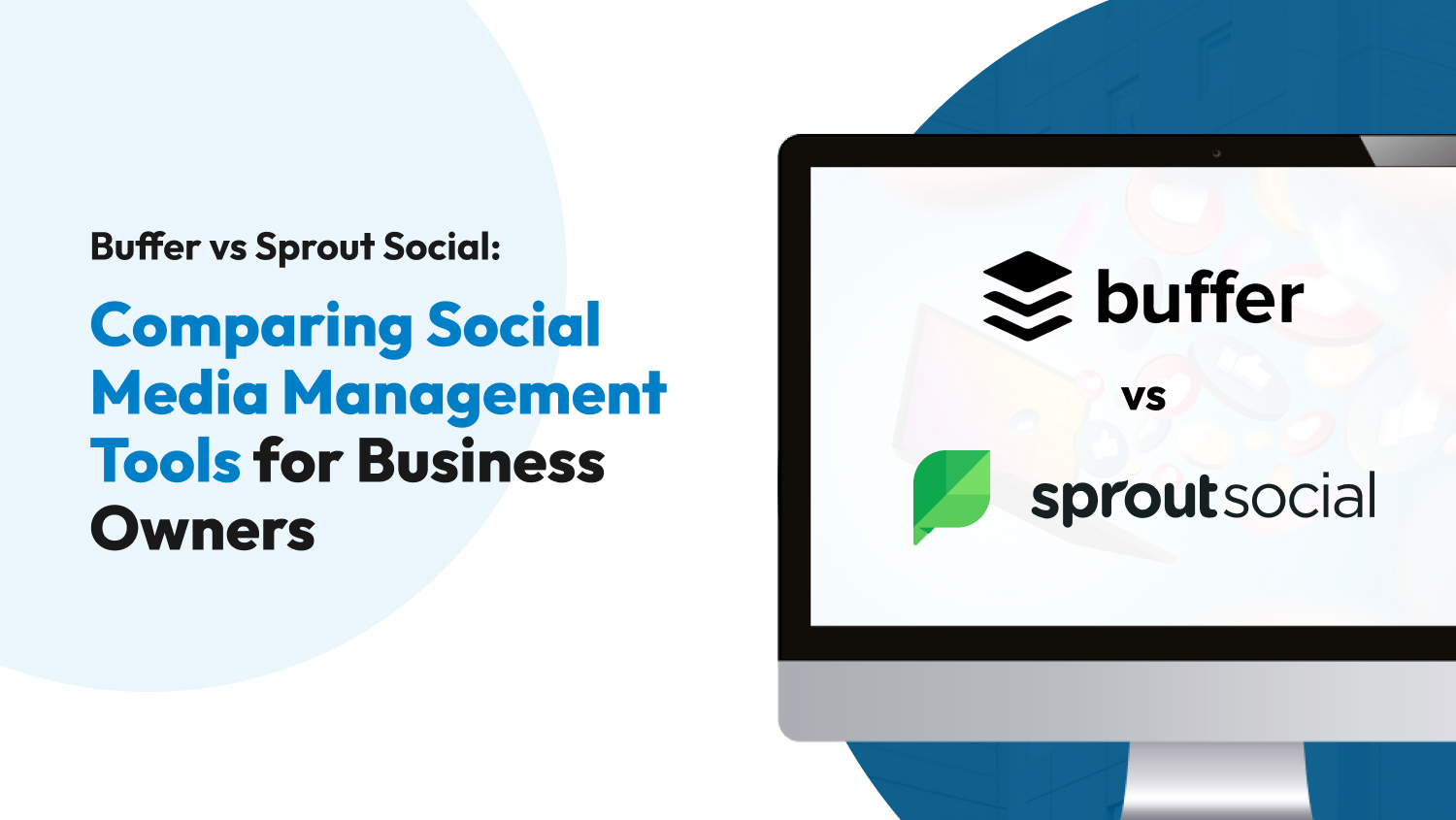Business
Buffer vs Sprout Social: Comparing Social Media Management Tools for Business Owners
Statistics show that 4.76 billion people now use social media worldwide — roughly equivalent to 60% of the world’s entire population. This data means 4.76 billion potential customers for your business that you can only reach through effective social media advertising.
As for marketing, you can’t go wrong with Buffer or Sprout Social as your daily social media management drivers. Each business has unique requirements, therefore, it is important to determine which of the two options — Buffer or Sprout — is better suited to fulfill your specific needs.
If you’re having a tough time choosing, we’ve got you covered. In this article, we’ll discuss the pros and cons of getting each software and help you decide which suits your venture better.
Buffer vs. Sprout Social: An Inside Look
Establishing fair criteria is step one in comparing platforms. For Sprout Social and Buffer, we’ll judge each software using the following benchmarks:
- Usability
- Social Media Connections
- Automated Publishing
- Content Creation Features
- Third-Party Integrations
- Reporting and Listening
- Team Collaboration
- Customer Support
- Cost
Usability
When picking any software, a key decision-maker is usability — how well-built a system is and how easy it is to navigate. A social media marketing tool should make each feature immediately accessible, and its interface must make sense.
Buffer is a solid choice for those who value simplicity and ease of use. Although it may be limited in features compared to Sprout Social, it provides an excellent user experience. It takes a minimalist approach to brand design, especially setup and navigation.
Sprout Social is a comprehensive social media marketing suite but still manages to have one of the cleanest interfaces we’ve seen. The number of features doesn’t get in the way of a seamless user experience. Your dashboard is clutter-free because it uses optimization algorithms to filter out unnecessary information. Moreover, it offers free onboarding for everyone.
As for accessibility, Buffer offers its software in English and Spanish, whereas Sprout Social has English, Spanish, French, Italian, and Portuguese.
Our Pick: Buffer is undoubtedly easier to navigate, but Sprout’s exceptional usability features make this category a tie.

Social Media Connections
A commissioned 2023 report shows that an average internet user bounces between seven different social media platforms a month. Covering all bases is vital in social media management, so getting a marketing tool with the most connections is critical in a successful business campaign.
For Sprout Social and Buffer, these tools can connect to the following social media platforms:
| Social Media Platform | Sprout Social | Buffer |
|---|---|---|
| Facebook or Meta | ✔ | ✔ |
| ✔ | ✔ | |
| ✔ | ✔ | |
| TikTok | ✔ | ✔ |
| ✔ | ✔ | |
| ✔ | ✔ | |
| Google Business | ✔ | ✔ |
| Messenger | ✔ | ✘ |
| YouTube | ✔ | ✘ |
| ✔ | ✘ | |
| Mastodon | ✘ | ✔ |
| Shopify | ✘ | ✔ |
Our Pick: Sprout Social (1-0) wins this category by connecting to more social media platforms.
Automated Publishing
Post-scheduling is a mainstay feature of every social media marketing tool. Not only must your posts be creative, but they must also be published consistently and on time.
Sprout Social offers several scheduling tools to make publishing a cakewalk. The first of which is a drag-and-drop Content Calendar. Beyond scheduling your posts, it can also help you keep track of events and holidays. Sprout Social also enables sharing your calendar with your team for a more fluid workflow.
Another exciting feature of Sprout Social is Automated Scheduling. This feature assesses your audience base and posts your content at the optimal time to post according to algorithms. You can post your content along with the first comment in Instagram for adding additional hashtags and discoverability, and you can even post stories on Facebook and Messenger.
On the other hand, Buffer has a limited scheduling feature. It has Buffer Queue, which lets you schedule posts for the whole month.
Our Pick: Another strong showing from Sprout Social (2-0) wins the round.
Content Creation Features
Content creation features remove the need for external content creation and streamlines your workflow.
Content creation isn’t Sprout Social’s forte, but it still has a simple photo editor with templates to choose from. Sprout Social also offers content curation, making locating content easy. This allows you to view unique and engaging content for inspiration.
Buffer also doesn’t have an intensive content creation base. It does, however, have Pablo as a content editor. It’s also one of the few social media marketing tools that offer an in-app landing page maker.
Our Pick: Both platforms are similar in content creation, so we’ll give this round another tie.
Third-Party Integrations
No matter how extensive a software is, it will still lack some features that you might find elsewhere. Third-party integrations allow your social media marketing tool to expand its feature base and unlock its full potential.
Sprout Social has a total of 26 native integrations, including popular tools such as Google Analytics, Google Drive, WooCommerce, DropBox, and the entire Microsoft 365 suite. It also has Hubspot and ZenDesk, but only for higher and more expensive tiers.
There are 28 native integrations in Buffer, which is more than what Sprout Social offers. Not only that, but Buffer can connect to Zapier and IFTTT — these tools allow your software to connect to even more applications through indirect integration.
Our Pick: Without a doubt, Buffer (2-1) is a better tool if you value third-party integrations.
Reporting and Listening
Creating a social media strategy without analytics is like driving a car with closed eyes. Effective social media marketing starts with data-driven insights — something Sprout Social and Buffer offer.
Buffer has a simple analytics dashboard that includes data on the following:
- Best Time to Post
- Content Performance
- Engagement
- Performance Insights
On the other hand, Sprout Social has a complete analytics dashboard which includes the following:
- Competitive Benchmarking: A measure of your performance against market standards.
- Impressions: Data on how many users engage with your content.
- Report Templates: Ready-to-deploy analytics templates for your dashboard.
- Sorted Engagement Statistics: Engagement data can be sorted per post, type, or demographic.
- Tags and Keywords: Data on how well your user-defined hashtags and keywords perform.
Moreover, Sprout Social has robust social media listening features, which are the following:
- Hashtag Monitoring: Report on how well a specific hashtag performs.
- Mention Monitoring: Report on how many people mention your social media accounts.
- Sentiment Analysis: An AI-driven insight into how people respond emotionally to your posts.
Our Pick: Buffer tries its best, but it can’t overcome the extensive analysis features of Sprout Social. (3-1)
Team Collaboration
Streamlining your workflow starts with seamless collaboration with your team. This is possible through in-app collaboration features in your social media management software.
Buffer offers complete team management. This includes giving and limiting access to collaborators. Permission levels allow a structured posting hierarchy within your team, which keeps members with different roles in their lane while avoiding micromanagement.
Sprout Social goes beyond what Buffer offers. The software does have access controls, but it also provides the following:
- Automated Task Distribution: Automatic tagging of tasks based on customer specifications.
- Collaborative Drafting: Real-time multi-access drafting of posts.
- Message Routing: Role-based funneling of incoming customer messages.
- Team Meetings: In-app virtual team meetups.
- Workflow Efficiency Tracking: Analysis of how efficient your team is.
Our Pick: Sprout Social (4-1) extends the lead again with a decisive win.

Customer Support
Missteps are unavoidable when exploring new software, and a small mistake may cost a lot when it comes to critical tasks such as marketing. That’s why effective social media management tools must have excellent customer support.
Unfortunately, Buffer has limited customer support. Its support team is only available from 4 AM to 8 PM ET on weekdays. Moreover, you can reach them through the following:
- Discord
- Messenger
From the get-go, Sprout Social customer support separates itself from its competition. It has free and extensive documentation of its features. You can contact their support team from Monday to Friday around the clock. You can also reach them through:
- Live Chat
- Phone Calls
- Ticket
Our Pick: Sprout Social (5-1) gets an insurmountable lead as we head to the final category.
Cost
And last but not least — platform cost. Assessing which software offers a more cost-effective choice for your business needs is important.
Buffer prides itself on an inexpensive solution to social media management. You can see how much Buffer costs per plan in the table below:
| Features | Free | Essentials | Team | Agency |
| Pricing | Free | $6/month per channel | $12/month per channel | $120/month per channel; $6/month per channel after 10 channels |
| Users | 1 | 1 | Unlimited | Unlimited |
| Channels | 3 | Unlimited | Unlimited | Unlimited |
They say good things come at a cost, which is undoubtedly true for Sprout Social. This is how much Sprout Social costs:
| Features | Standard | Professional | Advanced | Enterprise |
| Cost | Starts at $249/month | Starts at $399/month | Starts at $499/month | Custom |
| Users | Add $199 per additional user | Add $299 per additional user | Add $349 per additional user | Minimum of 5 |
| Channels | 5 | Unlimited | Unlimited | Minimum of 50 |
Our Pick: It’s better late than never for Buffer, as it secures its second point. (5-2)
Overall Thoughts
Our head-to-head comparison crowns Sprout Social against Buffer at a score of 5-2. However, don’t let this discourage you from choosing Buffer as your daily driver. In fact, there are many valid reasons why you should get Buffer in some cases.
For instance, Buffer is better for small or new businesses. Its intuitive interface allows even beginners to use its features easily. Overall, it’s a cost-effective solution to social media scheduling with tons of integration options that can extend its feature base.
Sprout Social, however, is a complete social media management suite designed for established businesses and enterprises. It has unmatched analysis, reporting, and listening capabilities. You can also manage your workflow better in Sprout Social, with automated publishing to make your life easier.
Both choices are excellent at their jobs. However, if you want to check out other platforms, you can also read up on our articles on:











